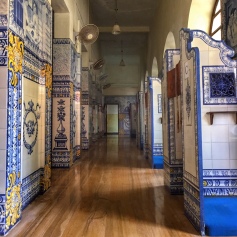If you’d asked me last year what my favorite country to visit was, I’d have said Portugal for sure. This year, I’ve spent so much time traveling that it’s a harder question to answer, but when I arrived in Goa, India, I was excited to see how much it reminded me of Portugal. I had no idea before I flew in that Goa was a Portuguese colony until as recently as 1961, but it was easy to see similarities once I learned this.

(1) The vibrant colors that you wish would appear more in your home country
One of my favorite things about Lisbon was “the color yellow” as I wrote about here. In Goa, I first arrived in the capital city of Panjim (aka Panaji) and saw not only the bright color of yellow I loved in Lisbon but also my favorite bright and bold shades of all the colors – purples, blues, and greens, on every building, with the red roofs of Portugal. The colors are especially prominent in the Fontainhas area of town, which means “little fountain”. Fontainhas has even been called “a small chunk of Portugal, washed up on the shores of the Indian Ocean” by historians¹.
(2) The seafood that makes you change your mind about seafood
The food in Goa was unlike the food I’d grown to love in Bangalore. Realizing that the food wasn’t going to be the same was a tough adjustment, especially because what I needed when I first got to Goa was comfort food. I’d essentially become vegetarian for the four weeks prior but I found in Goa that the vegetarians on our trip were often teased for that, which seemed odd in India. As I was there to immerse myself in the culture, per usual, I started eating what Goa is known for. That’s mostly seafood, just as in Portugal.
As I’ve written before on this blog, I love shellfish but I don’t often need more than a bite of “fish fish” – or so I thought. On my final day in Goa, my group took a boatride off of Baina Beach to go snorkeling. The captain of the boat caught a fish with what I think was a harpoon gun and we went ashore to a private area where he cooked the fish on a fire he made on the rocks. That fish was my final meal in Goa and one of the best I’d had in my two weeks there. Maybe I need to give fish more of a chance.
(3) The spicy sausage that feels just right after eating vegetarian for a month
Aside from seafood, I also kept being served a Goan sausage that felt familiar to me as something I had in Portugal. It might have been the spiciest thing I ate in all of India, but I liked that spice. I even had it as a pizza topping my final night in India. Yes, after all my talk of eating only Indian food when you’re in India, I ate pizza my last night. You can take the girl out of New York, but sometimes you just need a slice.
(4) The traditional dessert that makes you want to learn to bake

While the desserts are not similar from what I experienced in Portugal and Goa, they are both incredible. I wasn’t entirely impressed with any Indian dessert we ate in Bangalore aside from what I had on Food Street, but those weren’t dishes I found elsewhere.
Luckily, what I found as dessert in Goa was very different than what I’d found in Bangalore. At our homestay at Casa Menezes, my favorite dessert was something called Bebinca, which I ate more slowly than I’d ever eaten anything in my life, layer-by-layer, to savor the flavor. David, owner of Casa Menezes told us that this dish was first made at the convent of Santa Monica in Old Goa by a nun named Bebiana. The dessert makes use of the excess egg yolk that’s leftover when the egg white is used for the host for mass. This particular Bebinca was traditionally made with about 16 layers, each layer baked separately.
This dessert, not in taste, but in the way that I craved it, was reminiscent of the traditional pastel de nata that I had every day (and sometimes twice a day…and…sometimes three times a day) in Lisbon.
(5) The tiles that are way nicer than anything you’d see in a locker room
One of the best things about walking around Lisbon is seeing the buildings decorated with tons of tiles. I was pleased to see that this design element made its appearance in Goa as well. The most beautiful tiles I saw in Goa were in the confessional room of Our Lady of Pilar Church in the region of Seraulim. You’ll also find them as handicrafts in stores in Panjim, which I wish I’d bought but I was nervous about the shortage of rupees after they discontinued the 1000 and 500 rupee note with just a few hours notice. I also saw them at the entrance of Hotel Venite, a recommended restaurant that I’ll have to hit up next time, and even as plates for amuse bouche at The Novotel Hotel.
(6) The churches that make you want to confess all of your sins
I visited some gorgeous churches while in Portugal, and made a wish in each one, as you’re supposed to do, according to my mother. Since Goa was part of Portugal for quite some time, you’ll find there’s way more Christian influence than you might have expected coming to India.
Our Lady of Pilar Church not only had amazing tiling work as I mentioned above, but it also had a courtyard that reminded me of the cloisters in the Monastery of Jerónimo in Belém in Lisbon. In Panjim, I took note of the gorgeous white baroque-style Our Lady of the Immaculate Conception Church. While we weren’t allowed inside due to services, the outside was dazzling in sunlight that afternoon. Back in the day, when sailors first arrived in Goa, this was their first stop to thank God for a safe passage. The Basilica of Bom Jesus holds the remains of St. Francis Xavier. His body is taken out and shown publicly every few years. Way back in the day, there was a problem with people stealing his body parts for their own use, which feels kind of strange, but hey, you do you.
(7) The forts with views to die for
During my time in Goa, I visited two forts. Chapora Fort, in Bardez, was built in 1717, though a fort had been at that spot for over 200 years prior to that. It’s a tough walk up because the ground is full of pebbles and it’s quite steep – but it’s an even harder walk down if you can believe it. I think there was only one person out of our group of seven who didn’t fall flat on his behind during the walk down. But the views are always worth those hard walks, so do it anyway.
Cabo de Rama, south of Margao, was an easier walk up and down, as it’s much less steep. The plain area that it sits upon feels a little like you’re in Africa, as some of the Adventure bloggers pointed out when they visited. The fort offers beautiful views of Colva Beach and a tower to climb with really narrow steps. If you read the next section, you’ll find another reason to visit Cabo de Rama.
(8) The history that goes back way further than the founding of the States
I’m a history nerd, but I prefer learning about it much more when I’m THERE and in the place where things took place than if I’m sitting in a classroom or on a couch. I loved Belém in Lisbon for this reason, that it was the exact place where so many explorers took off to seek new lands.
My favorite experience while learning about the history of Goa was when we were up on the plains surrounding Cabo de Rama at sunset – also known as the Cola Plateau. Historian Sarvesh Borkar took us around and showed us the prehistoric artwork that he himself discovered. He poured water into the rock carvings to show them more prominently, and we saw carvings of a monkey, a fish, a deer, a cow, and several other animals. He then showed us some rock sculptures, one that was indicative of a calendar, and one that used to be a lion but its head had sadly fallen off at some point.
(9) A signature alcohol that is worth trying, even if it’s not your go-to

Porto, Portugal is known for its port wine (it’s not for me, as I wrote about here) and Goa, India is known for its feni. There are two types of feni – one distilled from coconut or palm trees, and one from cashew trees. It’s likely that coconut feni production began first, as those trees are indigenous while the cashew tree was imported from Portugal.
Our group tried feni our first night in mixed drinks at our kickoff party at Hotel Mandovi, a few nights later during a party at Casa Menezes, and one of our final days at Voltaire during a full feni tasting – complete with the history of feni, a lesson on the process, songs on the guitar about Goa, and mixed drinks. The alcohol is a little strong by itself, but I found I quite enjoyed it in mixed drinks. I preferred the feni made from coconut over that made from cashew. Feni is not at this point allowed to be sold outside of Goa, yet there is a hope from its producers that it become as known as the tequilas and scotches of the world.
—
If you also are as intrigued by Portugal as much as I am but want to try it with a little bit of Indian flair, look no further than Goa. Make sure to check out the #escape2goa hashtag on Instagram for more reasons to visit!
xx
I was in Goa, India to work on the Goa Department of Tourism’s #escape2goa project. Opinions are always and forever my own.
{Thanks to @andrew_talty90 for the photo of me and my backpack & @theworldwanderer for the other photos of me in this post.}




















Nice one Erin. Glad you had a lovely time in my tiny little state 🙂
LikeLiked by 1 person
Thanks so much! We had such a great time!
LikeLike
[…] India | 9 Ways Goa Feels like Portugal […]
LikeLike
[…] India | 9 Ways Goa Feels like Portugal […]
LikeLike
[…] I first arrived in Goa, I was staying in the capital city of Panjim, which reminded me so much of my time in Portugal. The bright, vibrant, but quiet neighborhood of Fountainhaus especially sent me back to that trip […]
LikeLike
Ours was the reverse experience… we lived in Goa most of our lives, and now are in love with Portugal. Can’t wait for the next visit.
LikeLike
I spent most of my life in Goa and since my first visit to Portugal, have fallen more in love with both of them. Can’t wait to visit Portugal again!
Incidentally, I love cashew feni (and always have a stock in my bar), and love Port wine as much 🙂
LikeLike
One of the things that I really like about your posts is how you tie in the historical roots of a city to the things you see even today. Many people do not realize that India has had so many foreign invaders, traders and scholars cross its shores, that it’s impossible to narrow “Indian traditions” to just a few festivals or foods. Keep exploring! #neverstoptraveling
LikeLiked by 1 person